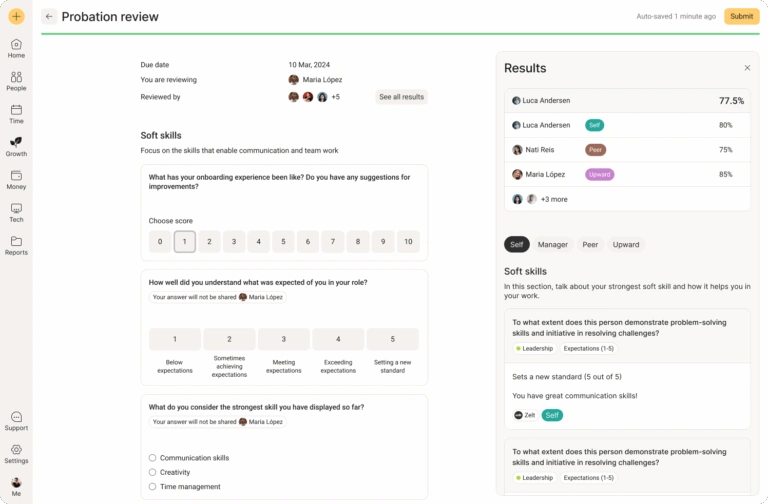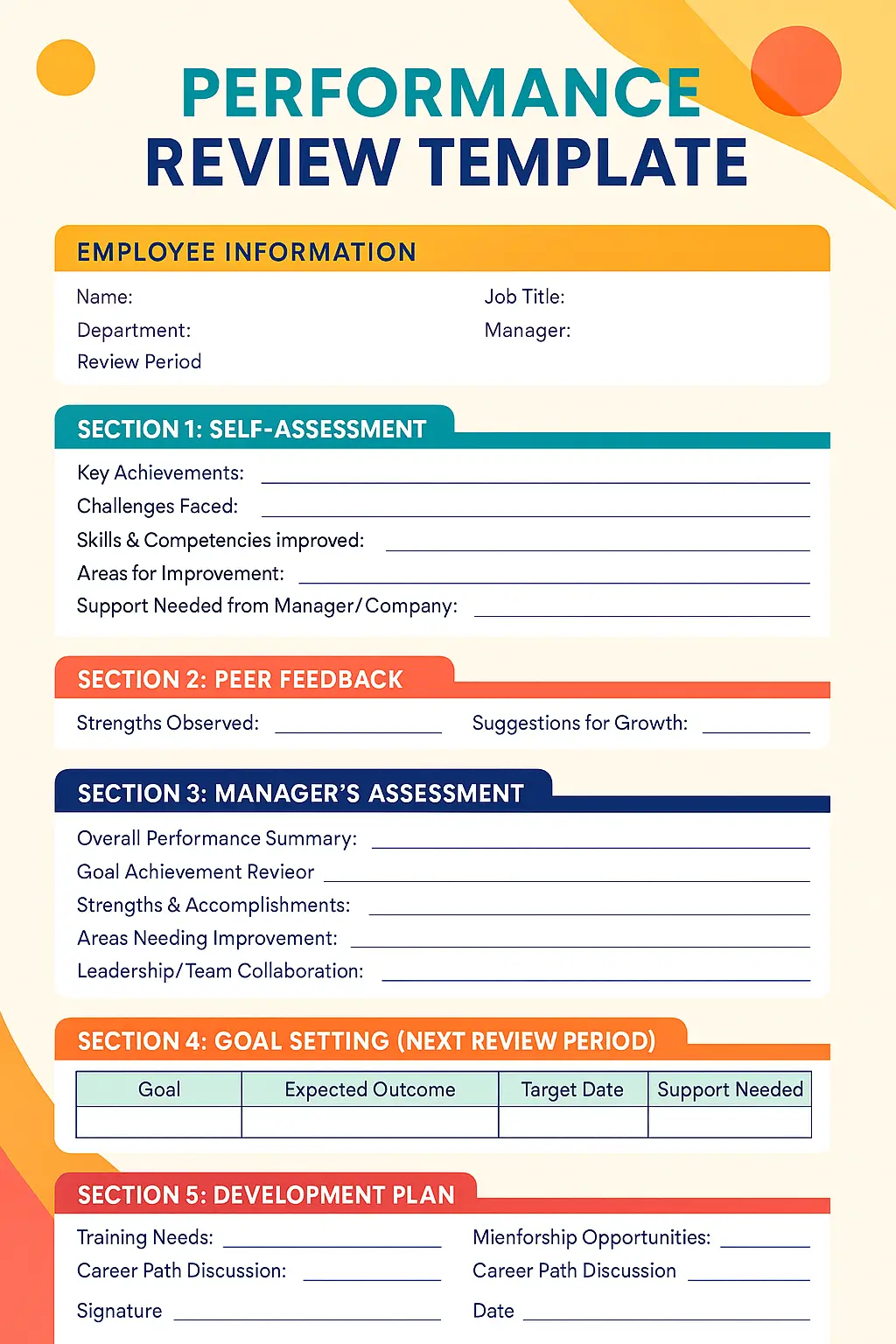16 Employee Feedback Examples & How to Use Them Effectively

For many managers, the challenging thing is to know how to phrase the feedback so it’s both constructive and respectful. That’s why they often look for practical employee feedback examples to guide their conversations. Modern organizations understand that meaningful, growth-oriented feedback benefits everyone.
In fact, according to Gallup research, 90% of employees who experienced negative feedback do not feel engaged. Negative feedback gives more harm than good. So, it’s important to give thoughtful and meaningful feedback.
To help with this, we have compiled 16 examples of employee feedback. You and your team can use them as a guide and learn how to give constructive and honest feedback that genuinely helps rather than hurts.
What is employee feedback?
Employee feedback means providing constructive comments for evaluation to employees regarding their behavior, work, and contributions in the workplace. It is important to create a positive work culture and to improve performance, which also helps the staff to understand where they are now and how they could do better. Feedback can be given by formal evaluations, informal conversations, peer assessments, and managerial discussions.
Why is employee feedback important?
There are many reasons why employee feedback is important but let us share a few of them.
Firstly, by providing employees with insights into their performance and improvement, it helps in development and personal growth. Additionally, it promotes motivation and also strengthens the communication and trust between managers and the team.
Without regular or effective input, these issues might appear:
- Confusion about goals
- Underperformance
- Demotivation
Moreover, by reinforcing positive behaviors and recognizing employees’ contributions, feedback increases productivity and engagement.
Types of employee feedback
It is crucial to give positive feedback in every input type, including formal or informal conversations or discussions between managers and peers. There are many types of employee feedback, which include positive (reinforcing), constructive (redirecting), negative , performance, peer to peer, etc. But the two key types that cover all of them and widely used are:
- Positive (Reinforcing) feedback
- Constructive (Redirecting) feedback
Our examples will focus on the feedback between employees and their managers with the purpose of creating a high-performing team and coaching them.
Positive employee feedback examples
Positive input motivates employees. It reinforces good behavior and encourages consistent performance. Here are practical examples you can use to acknowledge achievements, teamwork, creativity, and initiative in your team.
1. Consistency & reliability
“I can always count on you to deliver your work on time. Your reliability builds trust and keeps the team running smoothly.”
2. Teamwork & collaboration
“I really admire how you supported your colleagues during the product launch. Your collaboration ensured everything went smoothly.”
3. Efforts in a tough project
“The feature rollout was challenging, but you handled it with ownership and creativity. Customers are already seeing the value, thanks to your efforts.”
4. Leadership & initiative
“When you volunteered to lead the workshop, it showed initiative. The session was engaging and added real value to the team.”
5. Adaptability
“The sudden change in client requirements was tricky, but you adapted quickly. That flexibility helped us deliver without delays.”
6. Creative problem solving
“Your idea for simplifying the onboarding process was brilliant. It has already reduced errors and saved us valuable time.”
7. Recognizing customer impact
“The way you handled the client issue last week was excellent — your professionalism turned a frustrated client into a satisfied one.”
8. Highlighting attention to detail
“Your thoroughness in preparing reports ensures we don’t miss critical insights. It gives leadership more confidence in our data.”
Constructive employee feedback examples
Constructive guidance helps employees grow by identifying areas for improvement while maintaining a supportive tone. These examples show how to guide performance, communication, and collaboration effectively without discouraging your team.
9. Improving prioritization
“I know you’re handling many tasks, but I’d suggest focusing on Project Y first since it has the biggest impact. Let’s pause Project X for now.”
10. Addressing missed deadlines
“I’ve noticed a few recent deadlines were missed. I understand the workload is heavy, but please flag issues earlier so we can adjust priorities together.”
11. Encouraging quality improvement
“Your reports are informative, but some data sections are too detailed for leadership. Let’s simplify them with three main KPIs so they’re easier to digest.”
12. Encouraging openness to feedback
“Sometimes you become defensive when feedback is given. I value your contributions, but being open to suggestions will help you grow even faster.”
13. Clarifying expectations
“The presentation was good, but it didn’t fully address the client’s key concerns. Let’s review the brief together before the next meeting.”
14. Encouraging delegation
“You’ve been taking on too much yourself. Delegating some tasks will help the team grow and allow you to focus on higher-priority work.”
15. Improving time management
“You often stay late to finish tasks, which shows commitment, but it also signals we need better time management. Let’s explore tools to help you plan more effectively.”
16. Balancing detail with big picture
“Your analysis is very detailed, which is great, but sometimes we need a quick summary for decision-making. Try to balance detail with key takeaways.”
How to give employee feedback effectively
There’s no one-size-fits-all way to give feedback. Every employee, situation, and context is different, so effective feedback requires flexibility and thoughtfulness. Gallup says that feedback has the biggest impact when it is both timely and specific. If it comes too late or feels vague, the opportunity for growth is lost. You can use these basic tips while giving feedback:
- Be specific: Do not say “You’re wrong” straight away. Give an example of where and when the mistake happened and what result it had.
- Show empathy: Mistakes happen to everyone, so it is normal. You can find the solution together so they feel you are helping them.
- Propose solutions: It is one of the main goals because the purpose of giving input is not to criticize but to make improvements.
- Listen to employee input: Employees can also have ideas on which resources you can use to make them better.
Equally important is considering whose perspectives are included. Feedback should not flow only from manager to employee. The most effective systems also incorporate:
- Peer feedback to capture collaboration and teamwork.
- Upward feedback so managers can develop their leadership skills.
- Self-reflection to encourage accountability and growth.
This 360° approach ensures employees receive feedback that is balanced and trusted, while managers also grow through the process.
How to give feedback to your manager
Feedback should not be given in a one-way from managers to employees only. It should also travel upward from reports to their managers. Research supports that managers also need positive and negative inputs to improve their skills.
But the main problem is that if your company does not have a strong feedback culture. Giving input to the boss feels uncomfortable. So, the best way is to give input indirectly, by asking questions instead of saying directly.
Here is an example for better understanding:
Instead of saying directly: “You never give me clear instructions. How am I supposed to know what you want?”
You can say: “Could you walk me through your expectations for this task in more detail? That way I can make sure the outcome aligns with what you’re looking for.”
How to give feedback to coworkers
Companies have focused more on feedback for colleagues, by colleagues in recent years. Giving peer-to-peer feedback seems uncomfortable or full of fear. It feels awkward at the start, but according to research, peer insights boosts productivity up to 14%.
But the most important thing here is to set the right tone and context. Make it clear from the beginning that you don’t want to criticize. Your aim is mutual growth and learning.
Here are some key tips for giving feedback to colleagues:
- Set the right context
- Be specific
- Focus on positives
- Request feedback in return
- Keep tone light and collaborative
When to give employee feedback
As we’ve been discussing, the most obvious time for feedback is during performance reviews.

But relying on an annual cycle or end of probation isn’t enough — feedback given only once or twice a year is too infrequent to drive real growth. Employees can’t improve on what they don’t hear, and waiting months to recognize contributions or flag issues risks disengagement. That’s why many organizations are shifting toward a continuous feedback culture.
Top performing organisations do this by:
- More frequent conversations: Managers and employees check in regularly rather than waiting for annual reviews.
- Pulse surveys: Short, simple engagement surveys (usually done monthly) give teams a quick way to capture feedback trends across the company. They surface insights early and keep engagement high.
- In-the-moment recognition: Highlighting successes or coaching opportunities soon after they happen makes feedback far more impactful.
Many high performing teams use platforms like Zelt to run lightweight pulse surveys, on top of formal structured reviews, so feedback stays continuous.
Zelt makes employee feedback simple and impactful
Feedback is the foundation of growth, collaboration, and trust. Without regular or meaningful feedback, employees can feel disconnected and undervalued. But with structured and continuous performance insights , teams are motivated. It also improves performance and builds stronger workplace culture.
The examples we’ve shared above can help you get started. But to truly embed feedback into daily work, you can automate performance reviews with Zelt. This takes the process to the next level. Here’s how Zelt helps you making employee input easier, more structured, and more powerful:
Video Walkthrough
1. Run 360° performance reviews that drive growth
Zelt enables organizations to set up customizable performance review cycles, scheduled or rolling. You can easily collect input from managers, peers, direct reports, and employees themselves. With ready-to-use templates and a library of proven questions on leadership, engagement, and performance, you can design reviews that uncover real insights.
2. Turn feedback into actionable insights
Feedback shouldn’t just sit in forms. Zelt provides advanced analytics and comparison tools. It helps managers identify trends, track progress over time, and spot growth opportunities. This makes it easier to transform input into practical next steps for individuals and teams.
3. Build custom templates and questions
With Zelt, you can create reusable templates tailored to your organization. Add sections for different goals, choose from comment, scale, or multiple-choice questions. You can also adjust visibility settings to ensure feedback is transparent where needed and private where necessary.

4. Flexible review cycles to fit your workflow
Not every review needs to wait for year-end. With Zelt, you can:
- Set up scheduled reviews at fixed intervals (quarterly, annually, etc.)
- Run rolling reviews that automatically enroll employees at milestones, like finishing probation or reaching work anniversaries.
This flexibility means feedback becomes a continuous part of the employee journey, not a one-off event.
5. Empower managers with real-time notifications & reports
Managers get notified instantly when reviews are submitted for their
team. It helps them stay on top of feedback cycles. Employees receive published reports that summarize their growth journey. HR leaders can access historical data to track improvement across the organization.
Talk to an expert
Speak to us to learn how you can simplify performance reviews with Zelt.
Conclusion
Good feedback helps people feel valued and do better at work. Managers can use the above employee feedback examples to help them know how to talk with the team in a kind and useful way.
If you want to make the feedback stronger, then using HR management software like Zelt will be a great move. It helps you to give regular feedback instead of once a year. This makes it easier for employees and managers to grow together and build a positive workplace.
Frequently Asked Questions
How do you give someone feedback?
Start by being clear and specific about what you are addressing. Focus on the behaviour instead of the person and explain the impact it had. Keep a constructive and balanced tone. Mention what went well and what could be improved. Finally, invite their perspective and agree on next steps together so it feels like a two-way conversation.
How does formal feedback differ from informal feedback?
Formal feedback happens during one-on-one meetings with a manager or during performance reviews. While informal feedback happens casually during the day, such as giving a quick tip.
How do you give feedback to remote employees?
Giving feedback to remote employees can be tricky.
- If you can’t meet face-to-face, it is harder to understand tone and body language.
- Regular video calls help make feedback easier.
- Listening carefully in these calls lets you give each employee input in a way that works for them.


